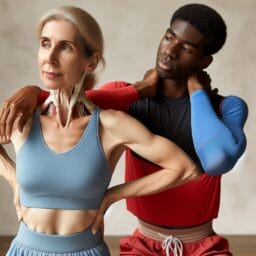
Top Stretching Routines to Enhance Your Strength Training
Table of Contents
- Introduction
- Benefits of Stretching for Strength Training
- Types of Stretching
- Pre-Workout Stretching Routines
- Post-Workout Stretching Routines
- Stretching Routines for Specific Muscle Groups
- Advanced Stretching Techniques
- Safety Tips and Best Practices
- Conclusion
- Frequently Asked Questions
Introduction
Hey, guess what? When you pair up dynamic stretching with your strength training routine, it’s like giving a high-five to your muscles – they get all warmed up and ready to lift those weights! Before you dive into the heavy stuff, try some active stretches. Wiggle around with lunges, arm circles, or leg swings to get those hip flexors and hamstrings limber. It’s kinda like doing a little dance that tells your body, “Hey, we’re about to do something awesome!”
Now for the cool part: after you’ve pumped iron and are feeling like a superhero, bring in static stretches. This is when you hold a stretch still – no bouncing or moving – just gentle pulls to let your muscles breathe out all their hard work. Proprioceptive neuromuscular facilitation stretching – yeah, it’s a mouthful – can be even better! It’s like making friends with your muscles; you stretch ’em out, give ’em a tiny break where they tighten up again (this is the facilitation part), then stretch some more.
Doing these stretching exercises will not only boost that flexibility but also help in improving strength training outcomes. You might even find yourself able to reach further and lift more than before because of your greater range of motion. So don’t skip on the stretches; they’re secret ingredients for your strength gains!
Benefits of Stretching for Strength Training
Did you know that by weaving stretching exercises into your strength training routine, you’re actually pumping up your muscles with a cocktail of awesome benefits? That’s right! Stretching isn’t just about touching your toes or reaching for the sky; it’s a powerhouse move that drives blood flow straight to those hard-working muscles. This rush of nutrients is like a superfood smoothie for your fibers, making them grow stronger and healthier.
Now, picture your muscles as elastic bands. If they’re all tight and knotted up, you won’t get much stretch out of them, right? But with regular dynamic stretching – think active movements where you’re not holding the position – those ‘elastic bands’ become more pliable. This means when it’s time to conquer those weights, you’ve got a full range of motion, letting you nail every rep with precision.
But wait, there’s more! After going beast mode on the iron playground, static stretches come into play. These are the stretches where you chill in one spot without bouncing around. By doing this, you’re giving your body a high-five for its hard work and helping it wind down. And here’s a pro tip: slot in some proprioceptive neuromuscular facilitation stretching to seriously level up your flexibility game.
So let’s take home this nugget of wisdom: slipping in hamstring flexibility drills and hip flexor soothers can be game-changers in muscle recovery too. They’re like a cozy blanket telling your muscles everything’s okay after an epic workout session – reducing soreness and waving goodbye to injury risks. Remember (but just this once!), next time you ponder skipping the stretches, think again! Your muscles will thank you for keeping them happy and healthy as they pump towards peak performance.
Types of Stretching
Imagine your body as a high-performance engine—stretching exercises are the premium oil that keeps it running smoothly. By incorporating static stretching into your strength training routine, you’re essentially fine-tuning your muscles. Static stretches involve holding a stretch without movement, giving those muscles a moment to relax and elongate after they’ve been worked out. It’s like telling them to take a deep breath and prepare for the next round of activity.
Now let’s kick things up a notch with dynamic stretching! This isn’t just your average warm-up; it’s an integral part of priming the body for muscular performance. Unlike static stretches, dynamic stretching involves active movements where joints and muscles go through a full range of motion. These activities get the blood pumping to all the right places, increasing flexibility and preparing your body for explosive vertical jump performance or that extra push during strength training.
And here comes the grandmaster technique: Proprioceptive Neuromuscular Facilitation (PNF) stretching. This advanced method combines passive stretching and isometric contractions, kind of like a dance between tension and relaxation. Not only does PNF ramp up flexibility but it also enhances muscular strength — think of it as the secret sauce in your workout regimen that helps improve strength training results.
Don’t forget about those hip flexors either; keeping them limber can transform your performance since tight hips can put a damper on lifting heavy weights. A well-rounded stretching program uses techniques tailored to target specific muscle groups, paving the way for greater range across all movement patterns.
So why settle for good when you can be great? Blend these various stretching techniques into your fitness mix, and watch as you reach new heights of agility and power in your strength training journey!

Pre-Workout Stretching Routines
Hey there, fitness pals! Let’s play a little game of “Did you know?” when it comes to the magic of stretching exercises for amping up your strength training. Did you know that active stretching goes beyond just getting you ready for action? It also boosts muscular performance in ways that’ll have you grinning from ear to ear as you see improvements in activities like sprinting and even vertical jump performance. You’re not just warming up; you’re setting the stage for some serious gains!
Now, imagine your body is a rubber band. If that band is all stiff, it’s not going to stretch far without snapping, right? That’s where dynamic stretching – those leg swings and arm circles – comes into the picture. They’re like the perfect pre-game pep-talk for your muscles, telling them, “We’ve got some heavy lifting coming up!” Here’s a fun way to slide these moves into your routine: start with 10 leg swings on each side to get those hamstrings singing. Then whirl those arms like a windmill 10 times each way because hey, who doesn’t want strong wings?
What about walking lunges? Take a stroll across the room with purpose! Each step is a stretch for those hip flexors (our unsung heroes) and a warm hug for your quads and glutes too. It’s not just exercise; it’s an adventure where every lunge whispers sweet nothings of encouragement to your lower body muscles.
These are more than just movements; they’re stepping stones leading to increased flexibility and greater range in whatever sport or activity tickles your fancy. So let’s mix up our workouts with these nifty tricks from our stretching toolkit, making sure we’ve got static stretches, PNF stretching (think of it as giving muscles their spa day), and plenty of active frolics that prep us for picking up weights or doing whatever makes us feel mighty!
Remember – oops, scratch that! – Keep in mind (better!), when strength training calls for backup, dynamic stretches are the first responders ensuring we’re limber and ready to conquer new challenges while keeping injury at bay. Now go on and stretch it out like nobody’s watching!
Post-Workout Stretching Routines
Did you ever stop to think that your mighty muscles could use a nice, relaxing stretch after a tough workout? Yup, it’s true! After you’ve finished lifting weights and feeling like the champion of the gym, those muscles need a bit of TLC. And what better way to do that than with some good ol’ static stretching. This isn’t just about reaching down to your toes; it’s about saying ‘thank you’ to each muscle for its hard work.
Here’s how you can treat your hamstrings, quadriceps, and calves to some post-workout love:
– For those trusty hamstrings: Ease into a forward fold and reach for your toes. Keep those legs straight but not too rigid – no locking knees! Hold this stretch and feel the gentle pull at the back of your thighs.
– Next up, the mighty quads: While standing, grab one foot behind you and gently pull towards your glutes. Keep that knee pointing down and hold on tight – balance is key!
– Finally, show some love to your calves: Find a wall or something sturdy, step one foot back, keep it flat on the ground and lean forward from the other leg. You’ll feel this in the lower leg muscle of the back foot.
This trifecta of static stretches helps increase flexibility in these often-overlooked parts while also getting you prepped for even greater ranges of movement next time around. Plus, by embracing hamstring flexibility and nurturing hip flexors with dedicated stretching techniques like acute static stretching or proprioceptive neuromuscular facilitation stretching (a fancy term for an advanced stretch), you’re setting up shop for improved strength training outcomes.
So remember (whoops – just kidding!), keep in mind that every rep counts, but so does every stretch. Give those muscles what they deserve after lifting all those heavy things—some quality time with static stretches—and watch as they repay you with incredible muscular performance!

| Muscle Group | Stretch | Description | Duration |
|---|---|---|---|
| Hamstrings | Forward Fold | Stand with feet hip-width apart, fold forward from the hips reaching towards your toes. Keep legs straight but knees not locked. | 15-30 seconds |
| Quadriceps | Standing Quad Stretch | While standing, grab one foot behind you, pull towards your glutes, and keep the knee pointing down while maintaining balance. | 15-30 seconds |
| Calves | Calf Stretch with Wall | Step one foot back, keep it flat on the ground, lean forward from the other leg against a wall or sturdy object. | 15-30 seconds |
Stretching Routines for Specific Muscle Groups
Alright, let’s talk about giving your lower body the stretchy love it deserves! Picture this: your hamstrings are like bungee cords ready to spring into action. To keep them super springy, try a routine where you’re sitting pretty on the floor with one leg tucked in and the other stretched out to the side. Reach for those twinkling toes and hold while humming your favorite tune. Your hip flexors will be over the moon with moves like kneeling lunges, where you gently shift forward until there’s a friendly chat happening between your hip and thigh. These stretches not only jazz up hamstring flexibility but also make those hip flexors as happy as clams at high tide!
Now swing those arms high – it’s upper body stretch time! Shoulders love circles as much as kids love merry-go-rounds, so whirl those arms good and proper. Then, morph into an imaginary bear hugging a giant tree—this opens up that upper back like a blooming flower in the morning sun. Keep these static stretches sweet and slow; they’re like secret whispers telling your muscles to take it easy after bench pressing or doing pull-ups.
Let’s not forget our core, the mighty manager of our body’s balance! Imagine yourself as a majestic cat stretching under the sun; arch that back for a purrrrfect stretch across your entire torso. This move isn’t just for show – it helps sync up all those core muscles so they can sing in perfect harmony while you squat, lift, and twist.
Mixing up these dynamic stretching routines with acute static stretching and proprioceptive neuromuscular facilitation stretching creates a full bouquet of benefits for muscular performance. It lets every part of you join in on the strength training party—because when one muscle group gets limber, they all want in on the fun! So spread out that exercise mat; it’s time to get stretching!
Advanced Stretching Techniques
Did you know stretching exercises are the secret sauce to your strength training? Let’s toss in a pinch of yoga and a sprinkle of pilates, and voilà! You’ve got yourself a recipe for muscular masterpiece. Just like a cat stretches every inch of its body after a lazy nap, slipping some yoga into your routine can help awaken those sleepy muscles. It’s about being bendy in all the right places so you can lift more and reach further. Pilates join the party by teaching your core how to be the life of it—strong, stable, and ready to support those big moves.
But wait, there’s more! Let’s talk about leveling up with proprioceptive neuromuscular facilitation stretching. This isn’t just any stretch; it’s like whispering secrets to your muscles on how they can grow stronger as they reach greater lengths. PNF is no joke—it’s like chess for your body where each move is calculated to push flexibility boundaries while boosting strength gains.
Mix these stretching techniques together, and what do you get? A full-range powerhouse that not only increases flexibility but also sets new records in vertical jump performance and active stretching prowess. So whether it’s touching the sky or squatting deep, remember (gotcha—just seeing if you’re paying attention!), keep in mind that dynamic stretching preps you up, static stretches cool you down, and everything in between keeps you balanced and mighty. Stretch out; it’s time to let those flexors fly!
Safety Tips and Best Practices
Guess what? Stretching isn’t just about reaching further; it’s also about not going too far! Sometimes, our eagerness to get super flexible can make us stretch more than our muscles are ready for. Ouch! That’s why it’s super-duper important to learn the right ways to do stretching exercises. Did you know that bending your back too much during a hamstring stretch can actually be a no-no? Yup, keeping your spine happy means you’ll be skipping away from injuries, not hopping towards them. And hey, those hip flexors and hamstrings aren’t just craving any stretches—they want the ones that are juuust right.
So, when you’re doing dynamic stretching or giving proprioceptive neuromuscular facilitation stretching a whirl, remember (oops—I mean “keep in mind”) – technique is king! Don’t dive into deep stretches without knowing how far your muscles can safely go. It’s like having a secret code that unlocks all the strength training goodies without tripping any alarms. By mastering stretching techniques with acute static stretching or active stretching smartly, we maximize benefits while waving goodbye to ouchies and booboos. And who wouldn’t want to avoid those? Happy, well-stretched muscles mean you can aim for greater range and full range moves in your workouts—safely rocking those muscle gains like a champ!
Conclusion
Hey fitness friends, guess what? Stretching does more than just make you flexible; it’s like a special elixir for your muscles! By embracing stretching exercises, you’re not only boosting muscular performance but you’re also setting the stage for some serious strength training success. Think of dynamic stretching as your personal cheerleader, getting those muscles jazzed up before you tackle the weights. It primes them to perform at their peak, so when it’s time to lift, you can do so with an impressive full range of motion – think soaring vertical jumps and powerful squats that leave everyone else in awe! And don’t forget about static stretches and proprioceptive neuromuscular facilitation stretching. They’re like the cool down party after a workout rave, helping your muscles relax and rebuild stronger than ever. When hip flexors and hamstrings get limber from such techniques, they pave the way for even greater gains in flexibility and strength. So go on, give those muscles the stretchy love they deserve and watch as your strength training rises to new heights!



